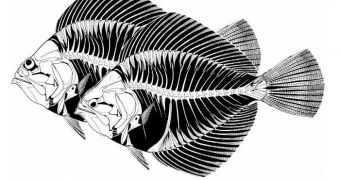The fossils of a fish that might have lived in the shallow reef waters of Europe some 50 million years ago, have been recently identified by researchers as belonging to a possible ancestor for modern flatfish. But unlike modern flatfish which have the eyes on one side of the head and which swim on their sides along the seafloor, the fossils appear to indicate that the fish had one eye on one side of the head and the other atop the skull, suggesting it was a transitional specimen in the evolution of modern flatfish.
"What we found was an intermediate stage between living flatfishes and the arrangement found in other fishes. These fossil fishes indicate that the evolution of the profound cranial asymmetry of extant flatfishes was gradual in nature. The important point is that many evolutionary biologists also could not imagine how the flatfish body plan could have arisen gradually, via a series of intermediates," said Matt Friedman of The Field Museum in Chicago.
Friedman says that the general belief amongst researchers is that modern flatfishes are the result of a lucky genetic mutation that took place in a single generation, albeit investigations regarding the fossils of species known as Heteronectes chaneti, Amphistium paradoxum or Amphistium altum found in Italy and Paris and housed by museums across Europe tell a totally different story.
"They were first figured in a publication over 200 years ago. So they have been floating around for some time now, but everyone said, 'Oh, they're symmetrical,'" Friedman said.
In fact these fish are anything but symmetrical, having eye orbits in mid-migration, which helped them to some extent adapt to their unique feeding and swimming technique.
Fossils indicate that they might have grown up to 30 centimeters in length and populated Europe's offshore water during the warm Eocene Epoch, about the same time modern whales and birds started to evolve. The new discovery gives credit to Darwin's theory of evolution which predicted that the transition of the eye of flatfish took place gradually over time through natural selection and provided the first piece of evidence indicating that intermediate flatfish existed in the past.

 14 DAY TRIAL //
14 DAY TRIAL //